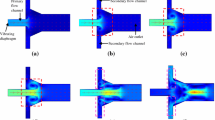Abstract
We experimentally study a high-speed synthetic jet actuator consisting of a cylinder with an orifice plate at the top and a piston driven by a motor. The experiments are performed for four orifice plates with a single hole or multiple holes with different diameters. The characteristics of the synthetic jets are investigated with cylinder pressure measurement and flow visualization based on the shadowgraph method, where the Mach disks in the shadowgraph images are used for estimating the Mach number of supersonic synthetic jets. A total orifice area on the plate affects cylinder pressure and jet Mach number. The number of the orifices has a direct influence on the downstream region where the jets from different orifices interact with each other. A smaller total orifice area results in a higher jet Mach number, a larger spatial extent of Mach disks, and an earlier formation of the Mach disks in one cycle. The influences of total orifice area are well explained by larger/smaller values of maximum/minimum values of the cylinder pressure for a smaller total orifice area. It is also found that the maximum jet Mach number is represented as a function of the maximum cylinder pressure even for different orifice configurations. Furthermore, for a given operating frequency, the maximum cylinder pressure increases almost linearly with the stroke length divided by an effective diameter of the total orifice area independently of the number of the orifices.















Similar content being viewed by others
References
Amitay M, Smith DR, Kibens V, Parekh DE, Glezer A (2001) Aerodynamic flow control over an unconventional airfoil using synthetic jet actuators. AIAA J 39(3):361–370
Amitay M, Pitt D, Glezer A (2002) Separation control in duct flows. J Aircraft 39(4):616–620
Anderson JD (1990) Modern compressible flow: with historical perspective, vol 12. McGraw-Hill, New York
Bar-Sever A (1989) Separation control on an airfoil by periodic forcing. AIAA J 27(6):820–821
Brunn A, Nitsche W (2006) Active control of turbulent separated flows over slanted surfaces. Int J Heat Fluid Flow 27(5):748–755
Buchmann NA, Atkinson C, Soria J (2013) Influence of ZNMF jet flow control on the spatio-temporal flow structure over a NACA-0015 airfoil. Exp Fluids 54(3):1485
Cattafesta LN III, Sheplak M (2011) Actuators for active flow control. Annu Rev Fluid Mech 43:247–272
Choi JJ, Annaswamy AM, Lou H, Alvi FS (2006) Active control of supersonic impingement tones using steady and pulsed microjets. Exp Fluids 41(6):841–855
Crittenden TM, Glezer A (2006) A high-speed, compressible synthetic jet. Phys Fluids 18(1):017,107
Enloe CL, McLaughlin TE, VanDyken RD, Kachner KD, Jumper EJ, Corke TC (2004) Mechanisms and responses of a single dielectric barrier plasma actuator: plasma morphology. AIAA J 42(3):589–594
Fernández JJP, Sesterhenn J (2017) Compressible starting jet: pinch-off and vortex ring-trailing jet interaction. J Fluid Mech 817:560–589
Forte M, Jolibois J, Pons J, Moreau E, Touchard G, Cazalens M (2007) Optimization of a dielectric barrier discharge actuator by stationary and non-stationary measurements of the induced flow velocity: application to airflow control. Exp Fluids 43(6):917–928
Gilarranz JL, Traub LW, Rediniotis OK (2002) Characterization of a compact, high power synthetic jet actuator for flow separation control. AIAA Paper 127(2002):12
Gilarranz JL, Traub LW, Rediniotis OK (2005a) A new class of synthetic jet actuators-Part I: design, fabrication and bench top characterization. ASME J Fluids Eng 127(2):367–376
Gilarranz JL, Traub LW, Rediniotis OK (2005b) A new class of synthetic jet actuators-Part II: application to flow separation control. ASME J Fluids Eng 127(2):377–387
Glezer A, Amitay M (2002) Synthetic jets. Annu Rev Fluid Mech 34(1):503–529
Goepfert C, Marié JL, Chareyron D, Lance M (2010) Characterization of a system generating a homogeneous isotropic turbulence field by free synthetic jets. Exp Fluids 48(5):809–822
Gad-el Hak M (2001) Flow control: the future. J Aircraft 38(3):402–418
Hwang W, Eaton JK (2004) Creating homogeneous and isotropic turbulence without a mean flow. Exp Fluids 36(3):444–454
Joslin RD (1998) Aircraft laminar flow control. Annu Rev Fluid Mech 30(1):1–29
Khorsandi B, Gaskin S, Mydlarski L (2013) Effect of background turbulence on an axisymmetric turbulent jet. J Fluid Mech 736:250–286
Lee C, Hong G, Ha QP, Mallinson SG (2003) A piezoelectrically actuated micro synthetic jet for active flow control. Sens Actuators A 108(1):168–174
Milanovic IM, Zaman KBMQ (2005) Synthetic jets in crossflow. AIAA J 43(5):929–940
Moreau E (2007) Airflow control by non-thermal plasma actuators. J Phys D Appl Phys 40(3):605
Tam CKW (1995) Supersonic jet noise. Annu Rev Fluid Mech 27(1):17–43
Tam CKW, Tanna HK (1982) Shock associated noise of supersonic jets from convergent-divergent nozzles. J Sound Vib 81(3):337–358
Traub LW, Sweet M, Nilssen K (2012) Evaluation and characterization of a lateral synthetic jet actuator. J Aircraft 49(4):1039–1050
Variano EA, Cowen EA (2008) A random-jet-stirred turbulence tank. J Fluid Mech 604:1–32
Variano EA, Bodenschatz E, Cowen EA (2004) A random synthetic jet array driven turbulence tank. Exp Fluids 37(4):613–615
You D, Moin P (2008) Active control of flow separation over an airfoil using synthetic jets. J Fluids Struct 24(8):1349–1357
Zhang S, Zhong S (2010) Experimental investigation of flow separation control using an array of synthetic jets. AIAA J 48(3):611–623
Acknowledgements
The authors would like to acknowledge Prof. A. Glezer for helpful comments on experimental apparatus and Drs. K. Mori and A. Iwakawa for their suggestions in the experiments. This work was supported by JSPS KAKENHI Grant no. 16K18013 and by Paloma Environmental Technology Development Foundation.
Author information
Authors and Affiliations
Corresponding author
Rights and permissions
About this article
Cite this article
Sakakibara, H., Watanabe, T. & Nagata, K. Supersonic piston synthetic jets with single/multiple orifice. Exp Fluids 59, 76 (2018). https://doi.org/10.1007/s00348-018-2529-9
Received:
Revised:
Accepted:
Published:
DOI: https://doi.org/10.1007/s00348-018-2529-9




